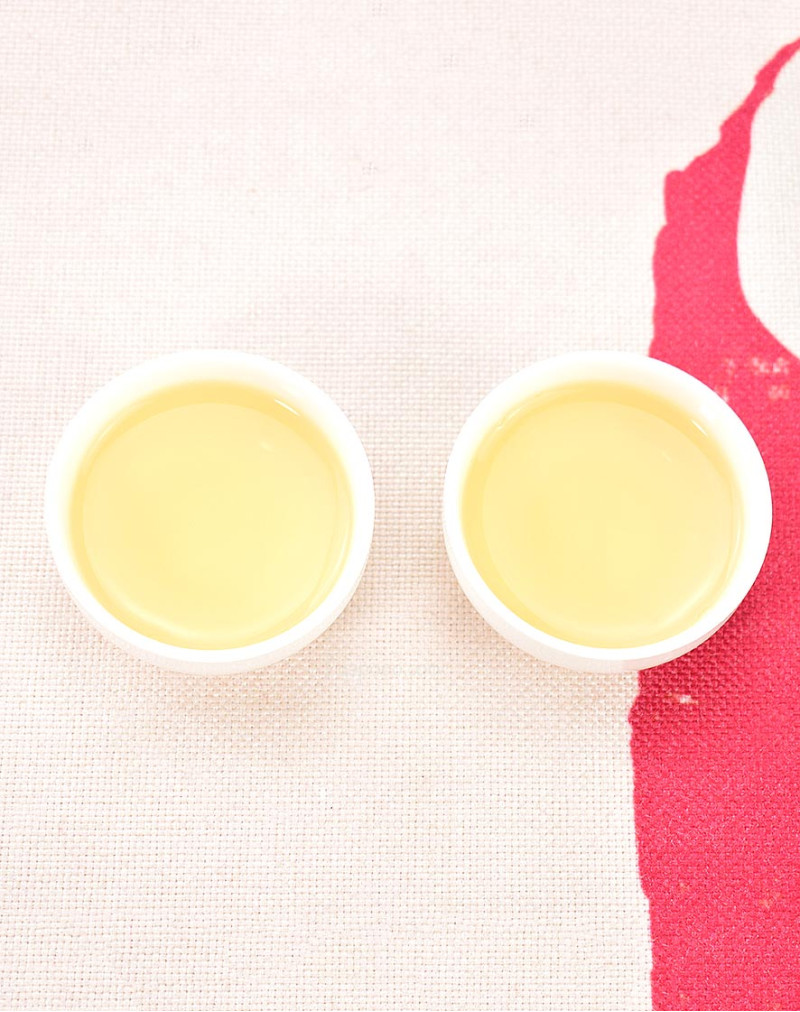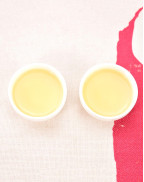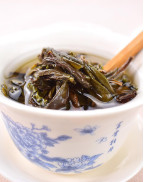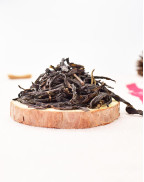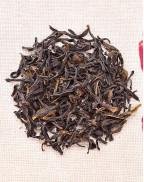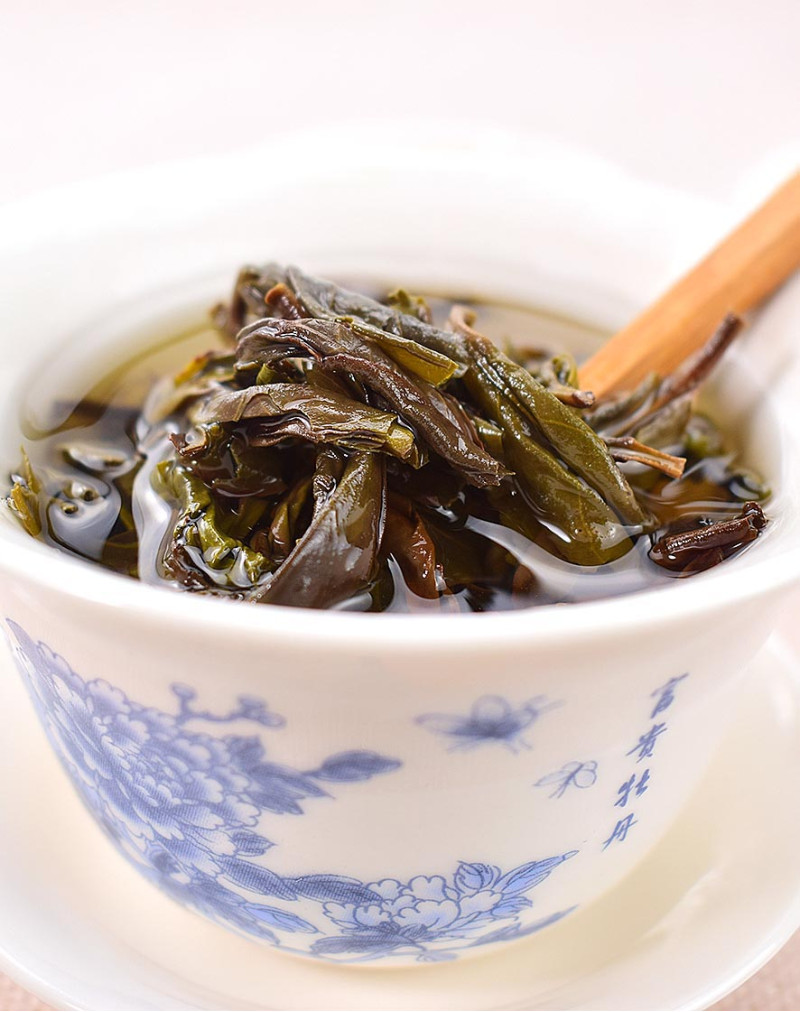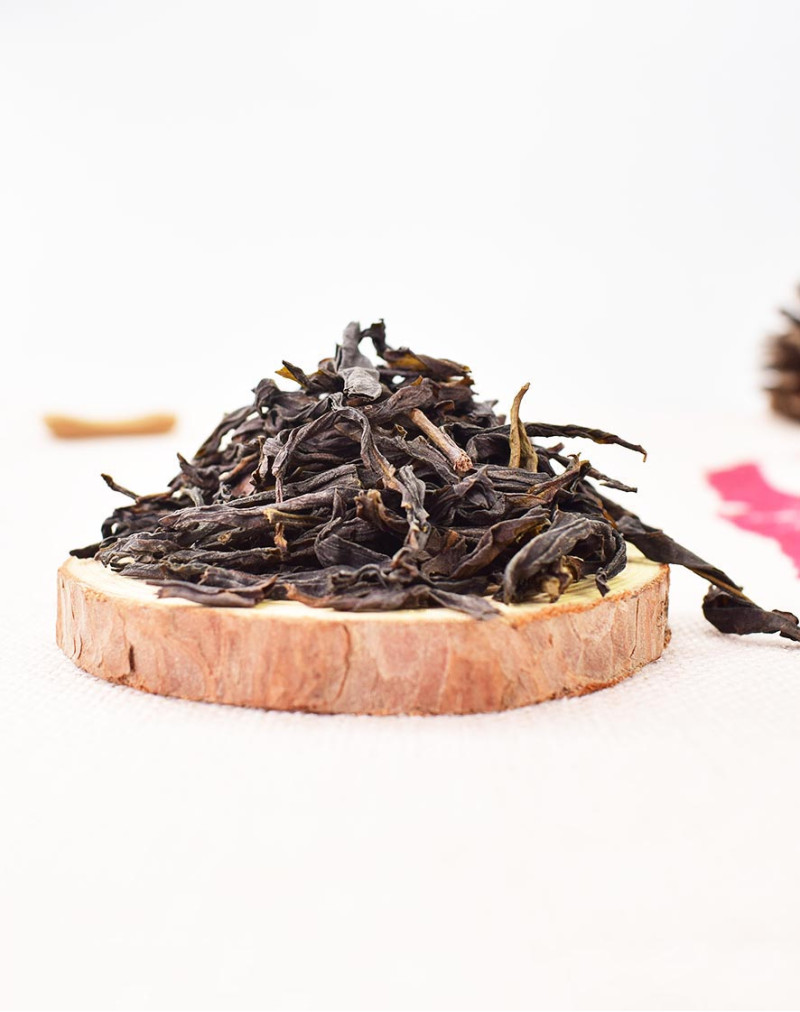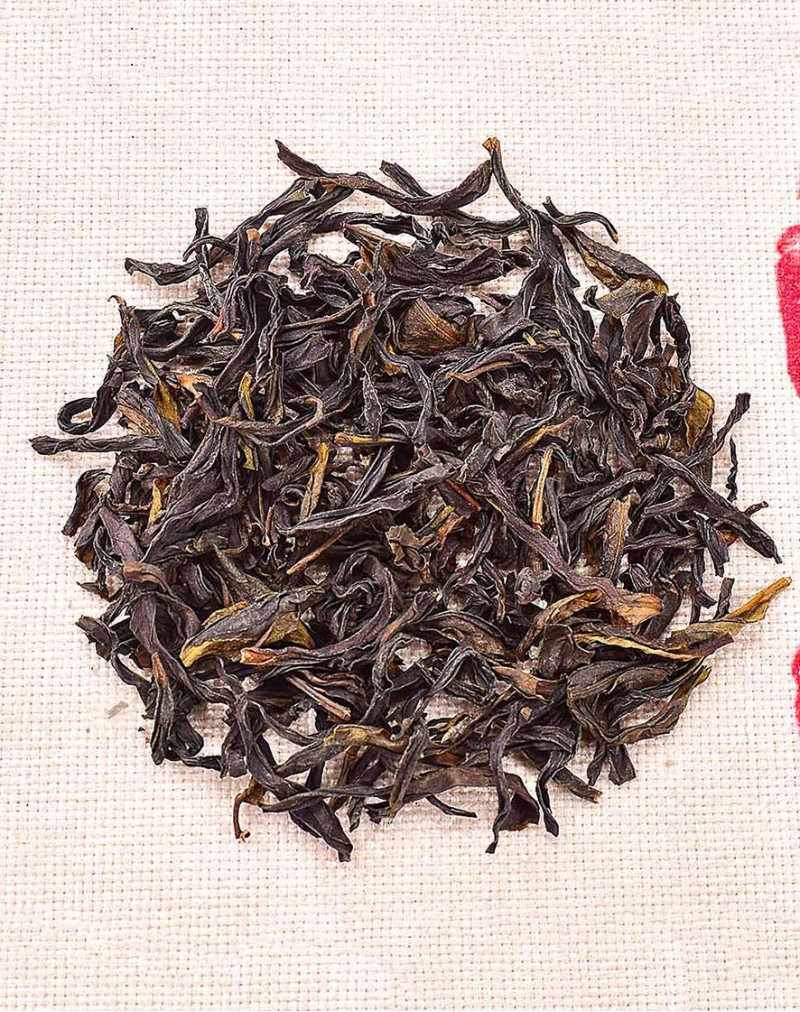"Duck Shit Scent" Ya Shi Xiang Dan Cong Oolong Tea
- Product Code: simple
- Availability: In Stock
Basic Info
Name: Duck Shit Scent" Ya Shi Xiang Dan Cong Oolong Tea
Category: Guangdong Dancong oolongs
Origin: Wudong village, Fenghuang Town, Chaozhou, Guangdong
Harvest: 6th, April 2024
Taste & Aroma: Lighter taste, "sheng jin" feeling, orchid, honeysuckle fragrance milky, lengthy delightful aftertaste
Item Form: Loose tea
Dry Leaf: Charcoal roasted, vivid black, heavy-body, twisted
Tree Species: Da Wu Ye (over 50 years old)
Aroma Type: Huang Zhi Xiang / Wile Honeysuckle
Altitude: 900m
Picking: One bud with two leaves
Tea Maker: Lao Huang
Leaf variety: Fresh leaves of large-leaf variety
Roast: Medium, Charcoal roasted twice
Liquor: Bright golden yellow
Shelf Life: 12 - 24 months
Storage: Store in dry and temperate condition. Keep away from odors. Sealed and refrigerated for a better long storage
Caffeine: Low
"Duck Shit Scent" Ya Shi Xiang Dan Cong Oolong Tea
"Duck Shit Scent" Ya Shi Xiang Dan Cong Oolong Tea
Unlike other China teas, which have a catchy name, the name of this tea does not sound appetizing. The tea you are looking at is definitely worth trying, despite its not-so-long history.
"Duck Shit Scent" Ya Shi Xiang Dan Cong Oolong Tea comes from the southeast slope of Phoenix Mountain in Chaozhou City, Guangdong Province, with an altitude of more than 500 meters, mainly produced in Phoenix Town."Duck Shit Scent" Ya Shi Xiang Dan Cong Oolong Tea belongs to Fenghang Dancong Tea category which is a famous fragrance variety of Oolong Tea in China.

Scenery Of Phoenix Mountain In Chaozhou
Show Full Description
The Phoenix Mountain Range, at the junction of Guangdong and Fujian, is one of the four major oolong tea producing areas in China. Phoenix Mountain is located in Fenghuang Town, about 40 kilometers north of Chaozhou. It has become a unique tourist landscape in Chaozhou with its beautiful scenery and a large number of ancient tea trees. Phoenix Bun in the Phoenix Mountains, 1497.8 meters above sea level, is the highest peak in Chaozhou and in eastern Guangdong.
Phoenix Mountain is shrouded in mist all day long, and there are many spectacular waterfalls.The air in the mountains is fresh, and there are many precious plants and animals. Standing on the top of the mountain, you can clearly see the Chaozhou city not far away.

Scenery Of Phoenix Mountain In Chaozhou
Phoenix Mountain has a warm and humid climate, abundant rainfall, fertile land and humid air, with an annual average temperature of about 20℃.The soil here is rich in organic matter and trace elements, which is very beneficial to the growth of tea trees and the accumulation of tea polyphenols and aromatic substances in tea leaves. This may be the main reason why Fenghang Dancon tea has unique" (山韻) mountain charm" -- a term to describe the unique taste of this tea.
"山韵(shan yun)"literally means "mountain rhyme" or "mountain charm". It is used to describe the taste and smelling characteristics of Fenghang Dancong oolong tea.This is similar to "Rock Rhyme", one of the characteristics of Wuyi Rock Tea.

Duck Shit Scent Tea Trees
Guangdong province
Guangdong province is not a significant producer of tea in China. However, the province is known for its high-quality tea processing industry, which transforms tea leaves from other regions into finished products for local and international consumers.

In addition to its tea processing industry, Guangdong also has a growing market for tea drinking, with an increasing number of tea shops and tea houses that offer a wide range of teas from all over China. With its thriving economy and thriving tea culture, Guangdong is an important hub for tea production, processing, and distribution in China.
Guangdong oolong
Guangdong oolong tea, also known as Guangdong Dancong tea, is a type of oolong tea produced in the Guangdong Province of China. It is known for its complex and floral aroma, and is highly prized by tea connoisseurs around the world.
The name "Dancong" literally means "single bush," which refers to the practice of cultivating each tea bush separately. This ensures that each plant has its own unique flavor profile, resulting in a diverse range of tastes and aromas among different batches of tea.
Guangdong oolong tea is harvested in the spring and autumn, and is typically processed using traditional techniques such as withering, rolling, and roasting. The leaves are oxidized to varying degrees, resulting in a range of flavor profiles from light and floral to dark and toasty.
What is Fenghang Dancong tea?
Fenghang Dancong (Phoenix single bush) is the representative of Guangdong Oolong Tea among the Four Great Oolong Teas of China.The other three are Minnan Oolong ,Minbei Oolong and Taiwan Oolong.. The degree of fermentation of Fenghang Dancong lies between full-fermented and non-fermented, so it is a semi-fermented oolong tea, which is mainly produced in Fenghuang (Phoenix )Mountain, Chaozhou City, Guangdong Province.
"單樅(Dancong) " means single bush. It has broad and narrow explanations in the field of tea processing. In a broad sense, it refers to the tea produced with unified processing methods in the same area. In a narrow sense, it refers to a kind of tea, whose fresh leaves come from the same tea tree, from picking fresh leaves to finished tea, without doping the leaves of other tea trees. In recent time, the term ""單樅(Dancong) " , as in this case, usually refers to a certain scent type.
The origin of the name:
The mother tree of "Duck Shit Scent" Ya Shi Xiang Dan Cong Oolong Tea grows in Pingkengtou Village, Fenghuang Town, Chao 'an County, Guangdong Province. It is about 80 years old, according to the observation of the tree's annual cycle. The owner of the tree is Wei Chunsai, a tea farmer who has passed away. It is said that the mother tree of "Duck Shit Scent" was introduced from Wudong Mountain, which is the second highest peak of Phoenix Mountain, with an altitude of 1,391 meters. Characterized by high yield, strong fragrance, "Duck Shit Scent" tea tree grows quickly, from grafting to tea production, only one year, so widely liked by tea farmers.
Good things usually have an appealing name. So why does this tea have such a disgusting name? There are many different opinions in China about the origin of the name of this tea, but basically it has nothing to do with the taste of "duck shit". Instead, the tea is most popular for its distinctive aroma, despite the offbeat feeling of its name.

A Large Tea Forest On The Phoenix Mountain
1. Misrepresentation
Rumor has it that a tea farmer (Wei Chunsai) once told visiting tea guests that the mother tree of ""Duck Shit Scent Tea" originally grew in "烏崠山" Wu Dong Mountain (above 1,000 meters above sea level). At first, this tree was ordinary and unremarkable. He transplanted the mother tree to his home in the low mountain area, but he didn't expect this tree to grow well on the "yellow loam" (locally called duck excrement soil) of his home. Similarly, what he did not expect was that the tea from this tree tasted so good that it caused an uproar in the town. When neighbors asked Wei Chunsai which tree this new tea came from, he was afraid that others would covet this tree, so he deliberately concealed it and said: this kind of tea is not special, I planted it in the "duck shit scent soil". Maybe the aroma has something to do with the soil. Of course, it seems that his ploy does not seem to work very well now.
2.Environment-related
It is said that "Duck Shit Scent" tea plant grows in a kind of local yellow soil called "鴨屎香土(duck shit scent soil)", plus its leaf shape presents oval-shaped and the dried tea made from this tea tree tends to become granular or lumpy, like piles of "duck shit", so people named "duck shit scent" tea.
"鴨屎香土" means ‘duck shit scent soil’, a native yellow soil containing limestone.
3.Shape-related
It is said that "Duck Shit Scent" tea plant grows in a kind of local yellow soil called "鴨屎香土duck shit scent soil", plus its leaf shape presents oval-shaped and the dried tea made from this tea tree tends to become granular or lumpy, like piles of "duck shit", so people named "duck shit scent" tea.
"鸭屎香土" means ‘duck shit scent soil’, a native yellow soil containing limestone.
A failed name changing

Young Duck Shit Scent Dan Cong Tea Tree
In May 2014, some local tea experts found that the fragrance of "duck shit scent" tea is very similar to a kind of honeysuckle grown in the local mountainous area. They advocated changing the name of this tea to a better name, "honeysuckle fragrance tea". But the name "duck shit scent" was so unique that it was already a household name in China. Surprisingly but reasonably, the new name doesn't seem to be popular and the initiative actually failed and this off-putting name remains today.
The fresh leaves of "duck shit scent" tea are very large and dark green in color, and smell like "黃枝香(yellow branch fragrance)", a strong yellow gardenia fragrance. Dry tea is characterized by its compactness, heavy body luster and fresh fragrance.
Baked with litchi wood moderately, without adding spices and artificial flavors, this kind of tea will naturally present a honeysuckle-like aroma and produce a strong milk flavor, which lingers on the tongue for a long time. This tea will be a great choice when you want to calm your mood.
Teapooo's "Duck Shit Scent" Oolong Tea comes from Phoenix Mountain and is made by the local tea farmer in traditional way. If you want to try Guangdong oolong tea and experience the special "(生勁)Sheng jin" or "(山韻)Shan yun" mouthfeel , this tea will not let you down.
About Oolong Tea
Oolong Tea(Wu-lung tea,烏龍茶, dark dragontea), also known as "Qing Cha (Celadon tea)", is a traditional semi-oxidized Chinese tea. It adopts part of the processing technology of green tea and the fermentation technology of black tea. It is a semi-fermented tea between green tea and black tea. It has many varieties and is one of the Chinese Six Major Tea types.
The processing methods of Oolong tea involves picking fresh leaves, withering, rolling, Zuoqing, stir fixation (frying green), rolling, firing/baking. These steps may vary in different kinds of oolong tea.
Oolong tea evolved from royal tea "Dragon-Phoenix Tea Cake'in the Song Dynasty (960-1279) and came out around 1725 (The Reign of Emperor Yongzheng in the Qing Dynasty). Oolong tea maintains the characteristics of green tea and black tea.
The manufacture of Oolong tea involves repeating stages to achieve the desired amount of bruising and browning of leaves. Withering, rolling, shaping and firing are similar to those of black tea, but more attention should be paid to timing and temperature.
Beiyuan (北苑茶) tea is the earliest royal tea kind in Fujian, and also the most famous tea after the Song Dynasty. There are more than ten kinds of tea works on tea making and brewing in Beiyuan area in history. Beiyuan was located in the area around Fenghuang Mountain in Jianou, Fujian province, where tea production could be traced back to the late Tang Dynasty(618 to 907).
Legend And Origin
The most important product among Beiyuan teas is Dragon-Phoenix Tea Cake. Historical documents show that people at that time had to pick a basket of fresh leaves to make a Dragon-Phoenix Tea Cake. Tea pickers often carry baskets full of fresh tea and bump along the mountain road to the place where tea is processed. It was usually dark when they arrived at the designated place. The leaves that have just been picked are tightly piled together and sway during walking, and the injured fresh leaves will breathe and emit heat. Slowly, some leaves will turn purple or brown (influenced by enzymatic oxidation). This random process is actually a kind of semi-fermentation, which is similar to the fermentation technology of making oolong tea today. So to some extent, Beiyuan Tea is the predecessor of Oolong Tea. Around 1725, some tea farmers in Anxi region invented oolong tea inspired by the tea making methods in Wuyishan region. In 1862, there appeared some tea shops specialized in selling oolong tea in Fuzhou, Fujian. In 1866, oolong tea made in Taiwan Province appeared in foreign markets. Now the largest oolong tea producing area in China is Anxi County, Fujian Province. In 1995, it was named as "the hometown of oolong tea" by the Ministry of Agriculture and China Agricultural Association.

The Pattern Of Dragon-Phoenix Tea Cake Recorded In Ancient Book
Most oolong teas, especially those with high quality, have unique varieties of tea trees, which are specially
used in specific varieties. The degree of oxidation, which varies according to the chosen duration of time
before firing, can range from 8 to 85%, depending on the variety and production style.
Characteristics of Oolong tea
Oolong tea is characterized by a tightly twisted appearance, resembling dragonfly head, or being spherical or hemispherical. Most oolong teas, especially some high-quality oolong teas, are named after the varieties of tea. Some varieties of tea trees are specially used to make certain oolong tea. The oxidation degree of oolong tea varies according to the length of time before roasting, tea varieties and production methods, and is between 10% and 70. The color of oolong tea varies greatly from place to place.For example, some Guangdong oolong teas are yellowish brown, some Taiwan Oolong teas are verdant green, and some Fujian Oolong teas are glossy jade, dark-green or emerald. Processing methods (such as the degree of fermentation or the amount of time spent roasting in a charcoal fire) can also change color of dry tea as well as tea soup.
The fermentation degree of oolong tea has a certain influence on its aroma, taste and mouthfeel. Like the color, the aroma and taste of oolong tea are directly related to the tree species, the time it was picked, the processing skills and brewing method. In other words, each kind of oolong tea has its own unique taste. Most oolong teas have strong floral, fruity and sweet flavors. People who love tea can choose oolong tea according to their personal preferences.
Classification Of Oolong Tea Based On Fermentation Degree
On the basis of fermentation, Oolong tea can be divided into slightly fermented tea (about 10% - 25%),
moderately
fermented tea (about 25% - 50%) and severely fermented tea (about 50% - 70%).
Different fermentation levels and production methods have a direct impact on the characteristics of finished Oolong tea. Taking aroma as an example, mildly fermented Oolong tea resembles green tea and has a clear fragrance (清香). Moderately fermented Oolong tea has strong fragrance. Heavily fermented type is similar to black tea with a honey aroma.
Fujian Oolong Tea
Oolong tea is mainly produced in three provinces in China: Fujian, Guangdong and Taiwan.As Tieguanyin is mainly produced in Fujian Province, some information about Fujian oolong tea will be introduced next.
The appearance of Oolong tea in southern Fujian and Northern Fujian are different.There are two different
distinct styles. The shape of Oolong teas in southern Fujian are rolled into long curly leaves, while that in
Northern Fujian are 'wrap-curled' into small beads (Dragonfly head), each with a tail resembling frog leg. The
taste of Fujian oolong tea has a lot to do with the variety of tea tree and the way it is processed.In terms of
the taste of Fujian oolong tea, though complicated,it can be generally divided into three types, each can be
subdivided into several smaller categories. Most of them have a very strong floral scent (such as orchid
fragrance and gardenia fragrance,etc).
Origin of the name of Oolong tea
In fujianese dialect, "oolong" means "confused ". Why is a very good tea called "confused" tea? The legend says
the invention process of oolong tea is related to an old tea farmer who one day went home along the rugged
mountain road on his back carrying a basket filled with freshly picked tea leaves. Perhaps he was too old
and the mountain was too rough. He walked slowly, and the tea leaves on his back bumped and rubbed against each
other as his body leaned involuntarily , resulting in a flower-like fragrance emitting from the basket.The tea
farmer did not know how to explain this strange phenomenon, so he called the tea "Oolong tea (confused tea)" and
later ‘Oolong tea’ became the common name for this kind of tea.

The Tossing And Cooling Skills Of Processing Tie Guan Yin
There is, of course, no proven basis for this legend. The processing technology of a new tea is the result of
numerous attempts, experiments and improvements. However, this story does make people remember the special
"摇青(Literally means shaking green tea leaves)" processing skill of
Oolong tea, and also knows that the aroma of Tie Guan Yin and Da Hong Pao comes from the key process of
"摇青(shaking green tea leaves)".
Production area
Oolong tea originated in Fujian and spread from Fujian to Taiwan and Guangdong. So far, the main producing areas of Oolong tea are distributed in Fujian, Guangdong and Taiwan.
Processing Of Oolong Tea
Step 1: Harvesting When tea buds of Oolong tea grows to half the size of fully grown leaf (开面采), at that time tea leaves of Oolong tea are plucked or harvested.
Step 2: Withering Freshly picked leaves are dried under sun to remove moisture, as the moisture level determines the time taken for tea polyphenols to oxidise.
Step 3: Bruising It is a continuation of the withering process . This process further removes moisture and grassiness. Tea makers shake the tea leaves in a basket and put pressure on it through hand. The tea leaves are then spread out.
Step 4: Fixation The tea leaves are then heated to stop the oxidation process and to kill the enzymes.
Step 5: Rolling The tea leaves are then rolled by handpressing to the desired shape.
Step 6: Baking Oolong tea is then heated slowly at low temperature for an extended period of time. This extended heating process is the reason for lasting after many infusions as compared to green tea.
Step 7: Sorting and Packaging Sub standard tea leaves are removed and good ones are packed.
Some of the above steps are repeated several times to achieve the desired amount of bruising and browning of leaves with much more attention to timing and temperature is necessary.
| Chinese Gongfu Method | |
| Tea | 6g |
| Water | Gaiwan 3oz / 85ml (Zisha teacup/teapot is Recommend) |
| Time | 8 - 12 infusions(rinsing,15s,25s,35s,45s,55s,75s,85s,100s, 120s,140s,170s) |
| Temperature | 100°c |
| Teapot Method | |
| Tea | 8g |
| Water | Teapot (17oz / 500ml) |
| Time | 1- 4mins |
| Temperature | 100°c |


